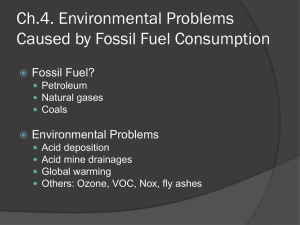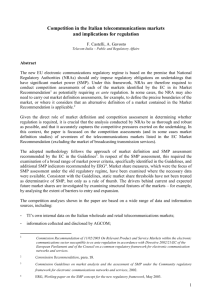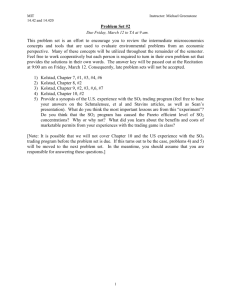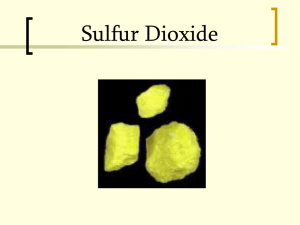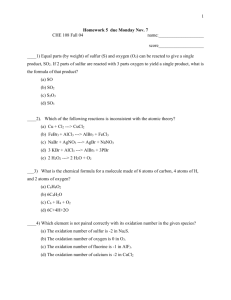parkinson Venus_PSS_.. - California Institute of Technology
advertisement
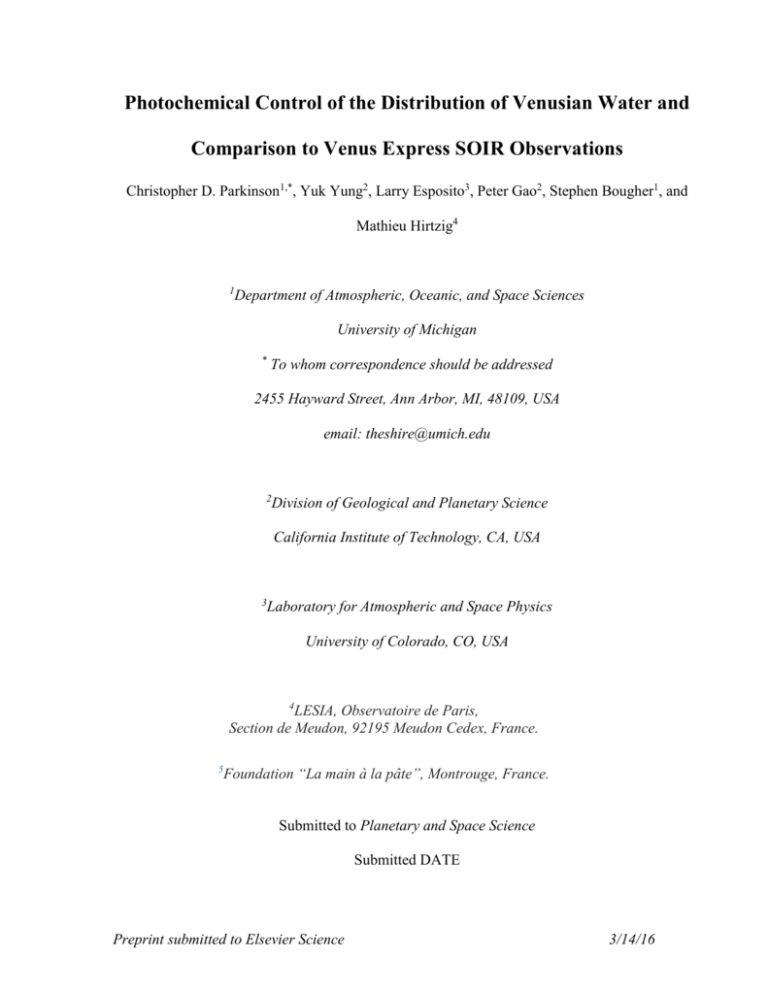
Photochemical Control of the Distribution of Venusian Water and Comparison to Venus Express SOIR Observations Christopher D. Parkinson1,*, Yuk Yung2, Larry Esposito3, Peter Gao2, Stephen Bougher1, and Mathieu Hirtzig4 1 Department of Atmospheric, Oceanic, and Space Sciences University of Michigan * To whom correspondence should be addressed 2455 Hayward Street, Ann Arbor, MI, 48109, USA email: theshire@umich.edu 2 Division of Geological and Planetary Science California Institute of Technology, CA, USA 3 Laboratory for Atmospheric and Space Physics University of Colorado, CO, USA 4 LESIA, Observatoire de Paris, Section de Meudon, 92195 Meudon Cedex, France. 5 Foundation “La main à la pâte”, Montrouge, France. Submitted to Planetary and Space Science Submitted DATE Preprint submitted to Elsevier Science 3/14/16 Abstract We use the JPL/Caltech 1-D photochemical model to solve the continuity diffusion equation for the atmospheric constituent abundances and total number density as a function of radial distance from the planet Venus. The photochemistry of the Venus atmosphere from 58 to 112 km is modeled using an updated and expanded chemical scheme (Zhang et al., 2010; 2012), guided by the results of recent observations. We mainly follow Zhang et al. (2010; 2012) to guide our choice of boundary conditions for 40 species. We fit the SOIR Venus Express results of 1 ppm at 70-90 km (Berteaux et al (2007) by modeling water from between 10 – 35 ppm at our 58 km lower boundary and using an SO2 mixing ratio of 25 ppm as our nominal reference value. We then vary the SO2 mixing ratio at the lower boundary between 5 and 75 ppm and find that it can control the water distribution at higher altitudes. 1. Introduction Venus is the closest planet to the Earth, in terms of both distance and mass. However, Venus has lost most of its atmospheric and surface water, most likely as an indirect consequence of its greater proximity to the Sun. Hence, much of the carbon dioxide on the Earth that has been processed by the oceans to produce carbonates is still free in the atmosphere of Venus. Subsequently, the Venus atmosphere is very massive by terrestrial standards, with a surface pressure of about 92 bars and a relatively high surface Preprint submitted to Elsevier Science 3/14/16 temperature at around 725 K. In the modern atmosphere of Venus, chemical reactions coupled with transport and radiative processes regulate the abundances of the most significant minor constituents. Of the utmost importance are the cycles involving water vapor, sulphuric acid, and their products, which maintain the cloud layers and involve reactions between the atmosphere and the surface. The atmosphere of Venus can be organized into regions determined by composition, chemistry, and clouds. The upper atmosphere, above ~110 km, has low densities and overlaps with the ionosphere so that photodissociation, ion-neutral, and ion-ion reactions are increasingly dominant with increasing altitude. The middle atmosphere, ~60–110 km, receives sufficiently intense ultraviolet (UV) radiation from the sun so that it is dominated by photochemistry. The lower atmosphere, below ~60 km, receives little UV radiation from the sun, and thermochemistry dominates increasingly with decreasing altitude owing to the high atmospheric temperatures. In the region near the boundary between the lower and middle atmospheres are the cloud and haze layers which extend from ~30–90 km with the main cloud deck lying at ~45–70 km. Competing processes between the middle atmosphere, dominated by photochemistry, and the lower atmosphere, dominated by thermochemistry (Esposito et al., 1997; Mills 2007) play a key role in this upper cloud deck region. Owing to massive cloud formation, lightning could occur and produce NO (Krasnopolsky, 2006) and heterogeneous chemistry on aerosol and cloud particle surfaces may be important (Mills, 2006; Parkinson et al., 2006; Yung et al., 2008). Finally, in the lowest scale height of the atmosphere a region exists where Preprint submitted to Elsevier Science 3/14/16 surface/atmosphere interactions most likely dominate. Following Yung and DeMore (1982), Krasnopolsky and Pollack (1993), Mills (2006), Yung et al. (2008) and others, three dominant chemical cycles have been identified in the Venus atmosphere: the CO2 cycle, the sulphur oxidation cycle, and the polysulphur cycle. The CO2 cycle features photodissociation of CO2 on the dayside with subsequent transport of a significant fraction of the products, CO and O, to the night side. Also important is the production of O2, emission of highly variable oxygen airglow on both the day and night sides, and conversion of CO and O2 into CO2 via catalytic processes. CO is very abundant (with mixing ratios of the order of a few parts per thousand by volume) in the upper atmosphere of Venus, as would be expected from the action of solar ultraviolet radiation on carbon dioxide. On the other hand, it is strongly depleted in the cloud layers (<1 ppmv) since it is involved in reactions with SO2 and the other species that make up the sulphur cycle. However, below the clouds and near the surface, the carbon monoxide value recovers to some few tens of parts per million by volume and shows a marked equator-to-pole increasing gradient (Collard et al., 1993; Taylor et al., 1995). It seems likely that CO is transported downwards rapidly from the thermosphere in the polar vortices to the troposphere, where it is gradually removed by reactions in the hot lower atmosphere and at the surface. The sulphur oxidation cycle involves conversion of OCS into SO2 and its subsequent upward transport, whereupon a significant fraction of the SO2 is oxidized to form H2SO4, which condenses with H2O to form most of the cloud and haze layers. The sulphuric acid is then transported downwards in the form of cloud droplets, which evaporate back into H2SO4 and H2O vapor below the clouds. The cycle is Preprint submitted to Elsevier Science 3/14/16 completed with the production of SO2 from the thermal decomposition of H2SO4. There is solid observational evidence for both the CO2 and the sulphur oxidation cycles. The putative polysulphur cycle until recently has been seen as more speculative but plausible based on existing laboratory data and limited observations. Recently, Yung et al (2008) described an innovative scheme involving the upward transport of sulphur as either SO2 or OCS, photodissociation to produce S, formation of polysulphur (Sx) via a series of association reactions, downward transport of Sx, thermal decomposition of Sx, and reactions with oxygen and CO to produce SO2 and OCS, respectively. Each of the cycles involves a number of trace species, such as ClOx, HOx, NOx, and SOx. The three cycles most likely interact through these trace species. The strength of these links between the cycles in existing models depends on parameters that have significant uncertainties and few constraints from direct observational evidence. 2. Model Description 2.1 Photochemistry and Chemical Kinetics The JPL/Caltech KINETICS model is a 1-D photochemical model that solves the continuity diffusion equations for the constituent abundances and total number density, n, as a function of radial distance from the planet. The number densities of the chemical species are calculated by solving the continuity equation for each species, i, ¶n i ¶fi + = Pi - Li ¶t ¶z (1) where the vertical flux i is given by Preprint submitted to Elsevier Science 3/14/16 f i = f iK + f iD (2) The eddy flux Ki f iK = -K( ¶ni n + i ) ¶z H av (3) represents the vertical flux that parameterizes macroscopic motions, such as the large scale circulation and gravity waves, while Di (4) is the vertical flux as a result of molecular diffusion. Hi and Hav denote the species and atmospheric scale heights, respectively; a small correction due to temperature gradients has been included. Pi and Li are the chemical production and loss rates (cm-3 s-1), respectively, at altitude z and time t (see, e.g., Chamberlain and Hunten, 1987; Yung and DeMore 1999). All the chemistry is contained in the Pi and Li terms. Di(z) and K(z) are respectively the molecular and eddy diffusion coefficients. The former is rigorously based on fundamental physics and laboratory measurements. The latter is usually derived empirically from observations of tracers in the atmosphere and are taken from Mason and Marrero (1970) and Atreya (1986) where applicable. We use the JPL/Caltech KINETICS 1-D photochemical model to produce an atmosphere with number densities of key species as a function of temperature and altitude. Our nominal reference model atmosphere parameters are the species mixing ratios (cf. Table 1) and the eddy diffusion at the homopause, Kh. The standard reference atmosphere used for this paper uses the mixing ratios from the models of Yung and DeMore (1982), Preprint submitted to Elsevier Science 3/14/16 Krasnopolsky and Pollack (1993), Mills et al (2006), Yung et al (2008), and Zhang et al (2010; 2012). The photochemistry of the Venus atmosphere from 58 to 112 km is modeled using an updated and expanded chemical scheme from Zhang et al (2010; 2012) for trace species, such as ClOx, HOx, and SOx combined with the results of recent observations. Sensitivity studies including an observationally constrained parameter space search of water and SO2 mixing ratios have been considered. Reactions using the peroxychloroformyl radical (ClC(O)OO) described by Pernice et al (2004) are included and O2 column values are within a factor of 2 of what was expected. Tables 2 – 4 list the most important reactions for the major compounds of carbon, oxygen, hydrogen, sulphur and chlorine. These tables also include their rate coefficients, with many updated from the values in Yung and DeMore (1982), as specified. Tables 2 and 3 show two and three body reactions (and their reaction rates), respectively. Table 4 shows the halogen reactions and reaction rates. The speculative reactions involving HSO3 and the (SO)2 dimer (and their rate coefficients) from Tables A1 and B1 of Yung and DeMore (1982) have not been included in this work. It is not our intention here to review or critically assess the very detailed analysis given by Yung and DeMore (1982) and Zhang et al (2010; 2012) except where immediately germane to the discussions below. In general, the chemistry for the various species is well defined and described elsewhere (e.g. Mills et al., 2006, Yung and DeMore, 1982; Krasnopolosky and Pollack, 1993; Prinn 1975). Rather, our starting point is to update the rate coefficients and eddy Preprint submitted to Elsevier Science 3/14/16 diffusion profiles of the JPL/Caltech KINETICS model (Zhang et al, 2010; 2012) from those used by Yung and DeMore (1982) for sensitivity studies at and above the cloud tops. 2.2 Temperature There exist experimental data on the atmosphere of Venus obtained after 1985, when the VIRA (Venus International Reference Atmosphere) or COSPAR model was published. For our calculations, we have adopted a standard reference temperature profile based on the VIRA data from the surface at 92 bar to 100 km, corresponding to 0.01 mbar. This temperature profile is shown in Figure 1. 2.3 Eddy Diffusion, K For most cases, K = Ko (n(z)/n_ref)-a, where Ko is the eddy diffusion coefficient at some reference altitude, n is the number density, z is altitude, and a is an exponent with value less than unity. The standard value for the eddy diffusion coefficient at the homopause, Kh, adopted herein is based on the work of Yung and DeMore (1982) which used a value of Kh 2 × 106 cm2 s−1. As the eddy diffusion profile, K, varies with height, z, we consider a profile such that Ko = Kh at the homopause. For the altitude range from 58 to 112 km, we have selected a profile following the above relation for K where a has the value of 0.5. This profile is also shown in Figure 1 and matches that given in Zhang et al (2010; 2012). 3. Results and Discussion Preprint submitted to Elsevier Science 3/14/16 The major pathways for the photochemistry of SO2 above the cloud tops are shown in Figure 2. SO2 exchanges rapidly with SO and SO3. However, formation of H2SO4 followed by condensation sequesters SO2 in aerosol particles and removes it from active chemistry. The reaction that forms H2SO4 appears to involve a complex with H2O: SO3 + H2O SO3·H2O SO3·H2O + H2O H2SO4 + H2O We adopt the expression for the rate of formation of H2SO4 from Lovejoy et al. (1996) Figures 3 to 5 show our standard reference atmosphere for key species. Figure 6 shows the VEx SOIR water mixing ratio profile from Berteaux et al (2008), from which we see that there is ~1 ppm of water between 70 – 90 km. Using our model, we try to fit the Berteaux et al (2008) SOIR observation as illustrated in Figure 7. This plot shows H2O resultant profiles obtained when we hold the SO2 mixing ratio to be fixed at the lower 58 km boundary at a nominal reference value of 25 ppm (Marcq et al, 2007) and vary water between 10 – 35 ppm at the lower boundary. We find the best fit to this SO2 mixing ratio boundary value corresponds to 18 ppm of water at the lower boundary of the model, which is consistent with the VEx VIRTIS SO2 measurement of 24 3 ppm (Marcq et al, 2006) at ~40 km. As expected, if the H2O lower boundary is increased, the amount of water above 70 km is stable and remains relatively constant, though much increased over our standard reference value. However, when the H2O lower boundary is decreased by only slightly, we witness a sudden collapse in the mixing ratio of water between ~70-90 km for our fixed standard SO2 boundary value. It recovers above 90 km Preprint submitted to Elsevier Science 3/14/16 owing to SO2 concentrations falling off rapidly above 100 km – near the upper boundary of our model simulations. Similarly, we can consider a fairly wide range of mixing ratios about our nominal value for SO2 at the lower boundary, viz., 5 ppm to 100 ppm while holding water fixed at the lower boundary. This successfully yields number density profiles of key species from 58 to 112 km above the surface. Our modeling agrees with previous measurements of SO2, SO, and CO (e.g. Mills 1998) as well as those in the companion issue of this paper by Mahieux et al (2014) (cf. Figure 5). First, we see that SO2 profiles can change significantly with changes of SO2 mixing ratio at the lower boundary as shown in Figure 8. For purposes of analysis we use a lower boundary mixing ratio of 18 ppm for water, which ensures that our model matches the Berteaux et al. (2008) observation of ~1 ppm of water between 70 – 90 km, as well as the Marcq et al. (2006) SO2 measurement of 24 3 ppm at about ~40 km. Although these species are part of the chemical pathway that produces sulphuric acid (H2SO4), the H2SO4 number density profile does not change for the cases considered since it follows the H2SO4 saturation vapor pressure curve. Similar to the water curves in Figure 7, we see that a higher mixing ratio of SO2 at the lower boundary results in a stable, large SO2 mixing ratio over most of our altitude range being considered, while lower SO2 mixing ratios at the lower boundary leads to a sudden decrease in the SO2 mixing ratio between 70 and 90 km. However, Figures 7 and 8 do not explain the whole story, as only the black curves are correlated (viz., 18 ppm water and 25 ppm SO2 for our standard reference case). There is Preprint submitted to Elsevier Science 3/14/16 a stronger interplay between H2O and SO2 than these plots reveal. Adjusting SO2 at the lower boundary for a fixed lower boundary value for water and looking at the varying SO2 profiles does not make it immediately clear the degree to which this affects the H2O profile for each case or for other lower boundary water mixing ratio values. What happens to the water profile over our altitude range when the SO2 mixing ratio increases or decreases just above the cloud deck region at 58 km corresponding to source pulse (i.e. changes in the transport rates for SO2 resulting in large changes in SO2 above the cloud tops) of SO2 from below this region? The same is true for changes in the water profile due to alteration of its lower boundary value while the SO2 abundance at the lower boundary is held fixed at the standard reference value. It isn’t immediately clear what general effects this has on the distribution of SO2 in the altitude range under consideration. Clearly, when we change the lower boundary values of these two species about the standard reference values, the profiles of these species change radically as well. We quantify this by separately plotting values for H2O and SO2 at ~80 km as a function of pairs of mixing ratios of these species at our lower boundary (58 km). This is shown in Figures 9 and 10, which together illustrate a remarkable phenomenon that we dub “chemical bifurcation”. Figure 9 represents our water sensitivity by plotting the mixing ratio of SO2 at 80 km and Figure 10 shows the SO2 sensitivity by plotting the mixing ratio of H2O at 80 km. We see that the two figures are “anti-symmetric” and that there is a dramatic chemical bifurcation in the middle of each plot. In regions of high SO2 abundance in Figure 9, we have a corresponding low H2O abundance in Figure 10, and vice versa. These results are hinted at in Figures 7 and 8, but the full impact is made clear Preprint submitted to Elsevier Science 3/14/16 in these figures. The way we can understand this is by realizing that both SO2 and H2O are removed above the cloud tops by the formation of H2SO4. As H2SO4 aerosols are removed, they represent a net sink of SO2 and H2O, thereby explaining their rapid decrease with altitude. The abundances of SO2 and H2O are of the same order of magnitude. An excess of H2O would result in the rapid removal of SO2 and vice versa. Hence, SO2 and H2O can regulate each other via formation of H2SO4. We interpret this as follows. In regions of high mixing ratios of SO2 there exists a “runaway effect” such that SO2 gets oxidized to SO3, which quickly soaks up H2O causing a major depletion of water between 70 and 100 km, thereby explaining the drastic changes in the 10 and 15 ppm curves of Figure 7. This reasoning can also be applied to regions of high H2O and applied to explain the sudden decreases in SO2 as seen in Figure 8. In the companion work of Mahieux et al (2014) in this issue, we see SO2 profiles as obtained by the SOIR instrument aboard the VEx spacecraft similar to those simulated in this paper in the altitude range of interest. The observed straight, vertical distributions of SO2 mixing ratios should correspond to regions of low water abundance, while other observations showing SO2 profiles remarkably similar to our black curve in Figure 8 should correspond to regions of high water abundance. For these and other similar cases, we’d expect to see a similar plot to the black curve in Figure 7 corresponding to this case. However, H2O could exhibit a bifurcation as its value falls below a critical value, which can be determined using Figures 9 and 10 for values other Preprint submitted to Elsevier Science 3/14/16 than the standard ones chosen for Figures 7 and 8. Further work on this in collaboration with the authors of that paper will be done to confirm these results and specifically answer whether, below a critical value, H2O could be completely sequestered in H2SO4 aerosols. Though our work could explain some of the observed variability in SO2 and H2O on Venus, it can also shed light on the observations of dark and light banding in the Venus atmosphere as viewed in the ultraviolet spectrum, possibly due to an unknown sulphur related UV absorber. Higher abundances of SO2 (and associated chemistry and subsequent formation of aerosols, as described by Bougher et al (2014) and Parkinson et al (2014), both companion papers in this issue) with the relative absence of water due to a chemical bifurcation could correspond to the darker regions, while areas of depleted SO2 and moderate to high values for H2O could correspond to the lighter regions, as lower SO2 abundances could be detrimental for the formation of such an UV absorber. Preprint submitted to Elsevier Science 3/14/16 REFERENCES: Atreya, S.K., Atmospheres and Ionospheres of the Outer Planets and their Satellites, Springer-Verlag, New York, 1986. Chamberlain, J. W. and D. M. Hunten, Theory of planetary atmospheres, an introduction to their physics and chemistry, Academic Press, Toronto, 1987. Collard, A. D., Taylor, F. W., Calcutt, S. B., Carlson, R. W., Kamp, L. W., Baines, K. H., Encrenaz, Th., Drossart, P., Lellouch, E., and Bézard, B. Latitudinal distribution of carbon monoxide in the deep atmosphere of Venus. Planetary and Space Science 41, 487–494, 1993. Esposito, L. W., Bertaux, J.-L., Krasnopolsky, V., Moroz, V. I., Zasova, L. V., Chemistry of Lower Atmosphere and Clouds, Venus II : Geology, Geophysics, Atmosphere, and Solar Wind Environment. Edited by Stephen W. Bougher, D.M. Hunten, and R.J. Philips. Tucson, AZ : University of Arizona Press,, p.415, 1997. Krasnopolsky, V. A., and Pollack, Modeling of OCS, CO, and H2SO4 Profiles in Venus' Troposphere, American Astronomical Society, 25th DPS Meeting, #24.22-T; Bulletin of the American Astronomical Society, Vol. 25, p.1098, 1993. Krasnopolsky, K. A., Chemical composition of Venus atmosphere and clouds: Some unsolved problems, Planetary and Space Science, Volume 54, Issue 13-14, p. 1352-1359, 2006. Mason, E. A., and T. R. Marrero, The diffusion of atoms and molecules, In Advances in Atomic and Molecular Physics, vol. 6, 155--232, edited by D. R. Bates and I. Esterman, Academic Press, New York, 1970. Krasnopolsky, V. A., Pollack, J. B., H2O-H2SO4 system in Venus clouds and OCS, CO, and H2SO4 profiles in Venus troposphere, Icarus 109, 58-78, 1994. Krasnopolsky, V. A., Chemical kinetic model for the lower atmosphere of Venus, Icarus, doi:10.1016/j.icarus.2007.04.028, 2007. Lu, C. W., Wu, Y. J., Lee, Y. P., Zhu, R. S., Lin, M. C., Experimental and theoretical investigation of rate coefficients of the reaction S(P-3)+OCS in the temperature range of 298-985 K, J. Chem. Phys. 125 (16): Art. No. 164329, 2006. Marcq, E., Encrenaz, T., Bezard, B., Birlan, M., Remote sensing of Venus‚ The lower atmosphere from ground-based IR spectroscopy: Latitudinal and vertical distribution of minor species, Plan. Space Sci. 54, 1360-1370, 2006. Mills, F. P., Allen, M., A review of selected issues concerning the chemistry in Venus’ middle atmosphere, Plan. Space Sci. doi: 10.1016/j.pss.2007.01.012, 2007. Preprint submitted to Elsevier Science 3/14/16 Mills, F. P., L.W. Esposito, Y. L. Yung, Atmospheric composition, chemistry, and clouds, in Exploring Venus as a Terrestrial Planet, eds. Esposito, L.W., E. Stofan, T. Cravens, American Geophysical Union, Washington, DC, Pp 73-100, 2007. Mills, F. P., I. Observations and Photochemical Modeling of the Venus Middle Atmosphere. II. Thermal Infrared Spectroscopy of Europa and Callisto. Ph.D. thesis, California Institute of Technology, Pasadena, CA, 1998. Mills, F. P., Coupled Sulphur and Chlorine Chemistry in Venus' Upper Cloud Layer, American Astronomical Society, DPS meeting #38, #26.06; Bulletin of the American Astronomical Society, Vol. 38, p.525, 2006. Parkinson, C. D., S. K. Atreya, A.-S. Wong, Photochemical Distribution of Venusian Sulphur and Halogen Species, B.A.A.S., XXXXX, 2006. Prinn, R. G., Venus - Chemical and dynamical processes in the stratosphere and mesosphere, (NASA, State University of New York, AAS, and AGU, Conference on the Atmosphere of Venus, NASA Goddard Institute for Space Studies, New York, N.Y., Oct. 15-17, 1974.) Journal of the Atmospheric Sciences, vol. 32, p. 1237-1247, June 1975. Sander, S. P., et al., Chemical Kinetics and Photochemical Data for Use in Stratospheric Modeling Evaluation Number 15. Jet Propul. Lab. Pub. 06-2, Pasadena, Calif. (http://jpldataeval.jpl.nasa.gov/), 2006 Taylor, F. W. Carbon monoxide in the deep atmosphere of Venus, Adv. Space Res. 16, 681-88, 1995. Yung, Y. L. and DeMore, W. B., Photochemistry of the stratosphere of Venus - Implications for atmospheric evolution, Icarus, 51,199-247, 1982. Yung, Y. L., Liang, M.-C., Jiang, X., Lee, C., Bezard, B., and Marcq, E., Modeling the Distribution of OCS in the Lower Atmosphere of Venus, J. Geophys. Res. 2009, DOI:10.1029/2008JE003094. Yung, Y. L., and W. D. DeMore, Photochemistry of Planetary Atmospheres, 1999, Oxford University Press. Zhang, X., Liang, M.-C., Mills, F. P., Balyaev, D., Yung, Y. L., Sulphur chemistry in the middle atmosphere of Venus, Icarus, 217, 714—739, 2012, doi:10.1016/j.icarus.2011.06.016. Zhang, X., Liang, M.-C., Montmessin, F., Bertaux, J.-L., Parkinson, C. D., Yung, Y. L., Photolysis of sulphuric acid as the source of sulphur oxides in the mesosphere of Venus, Nature Geoscience, 2010, DOI:10.1038/NGE0989. Preprint submitted to Elsevier Science 3/14/16 Table 1: Species CO2 CO O O(1D) O2 O2(1D) O3 H H2 H2O OH HO2 H2O2 S S2 SO (SO)2 SO2 SO3 S2O HSO3 Cl Cl2 ClO HCl HOCl ClCO COCl2 ClCO3 ClS ClS2 Cl2S Cl2S2 OSCl CLSO2 OCS Mixing ratio at lower boundary 0.965 25 ppm 0.0 0.0 0.0 0.0 0.0 0.0 0.0 18 ppm 0.0 0.0 0.0 0.0 0.0 0.0 0.0 25 ppm 0.0 0.0 0.0 0.0 0.0 0.0 0.1 ppm 0.0 0.0 0.0 0.0 0.0 0.0 0.0 0.0 0.0 0.0 1.5 ppm Flux at top of atmosphere 5.0 x 1011 -5.0 x 1011 -5.0 x 1011 0.0 9.0 x 108 0.0 0.0 0.0 0.0 0.0 0.0 0.0 0.0 0.0 0.0 0.0 0.0 0.0 0.0 0.0 0.0 -1.0 x 10-7 0.0 0.0 1.0 x 10-7 0.0 0.0 0.0 0.0 0.0 0.0 0.0 0.0 0.0 0.0 0.0 Table 2: Two Body reactions and rates R1 Reaction O3 + O O2 + O2 Preprint submitted to Elsevier Science Reaction Rate 8.010-12 e-2060/T Reference a 3/14/16 R2 R3 H + O3 OH + O2 H2 + O OH + H R4 R5 R6 H2 + O(1D) OH + H H2O + O(1D) OH + OH OH + CO CO2 + H R7 R8 R9 OH + O O2 + H OH + H2 -> H2O + H OH + OH H2O + O R10 R11 R12 OH + O3 O2 + HO2 HO2 + O OH + O2 HO2 + O3 O2 + O2 + OH R13 HO2 + H OH + OH H2 + O2 H2O + O HO2 + HO2 H2O2 + O2 HO2 + OH O2 + H2O H2O2 + OH H2O + HO2 O(1D) + CO2 O + CO2 S + CO2 SO + CO S + O2 SO + O S + OH SO + H S + HO2 SO + OH S2 + O SO + S SO + O2 SO2 + O SO + O3 SO2 + O2 SO2 + O3 SO3 + O2 SO + OH SO2 + H SO + HO2 SO2 + OH SO + SO SO2 + S SO3 + H2O H2SO4 SO3 + SO 2SO2 HSO3 + O2 HO2 + SO3 HS + O SO + H HS + H S + H2 HS + S H + S2 HS + HS H2S + S H2S + O HS + OH H2S + H HS + H2 R14 R15 R16 R17 R18 R19 R20 R21 R22 R23 R24 R25 R26 R27 R28 R29 R30 R31 R32 R33 R34 R35 R36 R37 Preprint submitted to Elsevier Science 1.010-10 e-366.95/T 3.4410-13 e-3160/T (T/298.0)2.67 1.110-10 1.010-10 1.4410-13 (1.0 + n/4.01019) 2.410-11 e224/T 7.710-12 e-2100/T 6.210-14 e945/T (T/298)2.6 1.7210-12 e-940/T 2.710-11 e224/T 2.0310-16 e693/T (T/300)4.57 (7.2e-11 + 5.6e-12 + 2.4e-12) b c 1.510-12 e19/T 4.810-11 e250/T 2.9110-12 e-161/T 7.4110-11 e120/T 1.010-20 2.110-12 6.5910-11 3.110-11 2.010-11 e-84/T 1.610-13 e-2280/T 4.510-12 e-1170/T 3.010-12 e-7000/T 8.5910-11 2.310-11 3.510-15 9.010-13 1.9910-15 1.310-12 e-330/T 1.6010-10 2.1610-11 4.9810-12 4.0010-11 9.2110-12 e-1800/T 2.3110-7 (T/298)1.94 e-455/T f a g a c a a c a a c a a c a a or < 40 km a a a a a a a a d a c c c c c c e 3/14/16 R38 R39 R40 R41 R42 H2S + OH HS + H2O HS + O3 HSO + O2 HS + HO2 HSO + OH HSO + O2 SO2 + OH HSO + O3 HS + 2O2 6.110-12 e-80/T 9.510-12 e-280/T 1.010-11 1.710-15 2.5410-13 e-384/T a a a a a Table 3: Three Body Reactions and rates R43 R44 R45 R46 R47 R48 R49 R50 R51 Reaction O + CO + M CO2 + M O + O + M O2 + M O2 + O + M O3 + M H + O2 + M HO2 + M 2H + M H2 + M S + S + M S2 + M SO + O + M SO2 + M SO2 + O + M SO3 + M SO2 + OH + M HSO3 + M Reaction Rate 2.2110-33 e-1780/T n3 5.2110-35 e900/T n3 6.010-34 (T/300.0)-2.6 n3 5.4 10-32 (T/300)-1.8 n3 8.8510-33 (T/298)-0.6 n3 1.1810-29 5.1010-31 8.010-32 e-1000/T 4.3910-23 T-3.3 Reference h i a a j a a k a Table 4: Halogen species reactions and rates R52 R53 R54 R55 R56 R57 R58 Reaction HCl + O(1D) products HCl + O OH + Cl HCl + H H2 + Cl HCl + OH H2O + Cl Cl + O3 O2 + ClO Cl + H2 HCl + O Cl + HO2 HCl + O2 R59 Cl + HO2 OH + ClO R60 R61 R62 R63 R64 Cl + H2O2 HCl + HO2 ClO + SO2 Cl + SO3 Cl + HS HCl + S Cl + H2S HCl + HS ClO + SO Cl + SO2 Reaction Rate 1.510-10 1.010-11 e-3300/T 2.3910-11 e-1730/T 2.6110-12 e-350/T 2.9110-11 e-260/T 4.710-11 e-2300/T r1 = 1.810-11 e171/T r2 = 4.110-11 e-448/T r1/(r1+r2) r1 = 1.810-11 e171/T r2 = 4.110-11 e-448/T r2/(r1+r2) 1.110-11 e-980/T 1.010-18 1.110-10 3.710-11 e210/T 2.8110-11 Reference c a c c c c c c c c c c c (a) Sander et al. (2006) (b) Yu and Varandas, (1997) Preprint submitted to Elsevier Science 3/14/16 (c) Yung and DeMore (1982) (d) Gericke and Comes (1981) (e) Atkinson (1989) (f) Christensen et al. (2002) (g) Int. J. Chem. Kinet. 14 1149 1982, 250-370K, 0.03-0.04Bar, Ar, measured (h) Inn, E.C.Y., 257-272, 1974 (i) Tsang and Hampson 1986 (j) Baulch (1992) (k) Krasnopolsky (2006) (l) Molina et al. (1981) (m) Moses et al. (2002) (n) Yung et al (2008) Branching ratio estimated (o) Lu et al. (2006) (p) Mills (1998) (q) Yung et al (2008) Estimated based on analogy with O + CO + M CO2 + M Figure Captions Figure 1: Temperature profile and Eddy Diffusion Coefficient Figure 2: Chemical pathways of importance Figure 3: VEx SOIR water mixing ratio profile plot (Berteaux et al, 2008) Figure 4: SOx profiles std ref Figure 5: HOx profiles std ref Figure 6: ClOx profiles std ref Figure 7: Water mixing ratio profiles with fixed SO2 lower boundary of 25 ppm: H2O 10-35 ppm Figure 8: SO2 mixing ratio profiles with fixed H2O lower boundary of 18 ppm: SO2 5100 ppm Figure 9: Water sensitivity study: Mixing ratio of SO2 at 80 km Figure 10: SO2 sensitivity study: Mixing ratio of H2O at 80 km Preprint submitted to Elsevier Science 3/14/16 Figure 1: Preprint submitted to Elsevier Science 3/14/16 Figure 2: Preprint submitted to Elsevier Science 3/14/16 Figure 3: Figure 4: Figure 5: Preprint submitted to Elsevier Science 3/14/16 Figure 6: Preprint submitted to Elsevier Science 3/14/16 Figure 7: Figure 8: Preprint submitted to Elsevier Science 3/14/16 Figure 9: Preprint submitted to Elsevier Science 3/14/16 Figure 10: Preprint submitted to Elsevier Science 3/14/16
